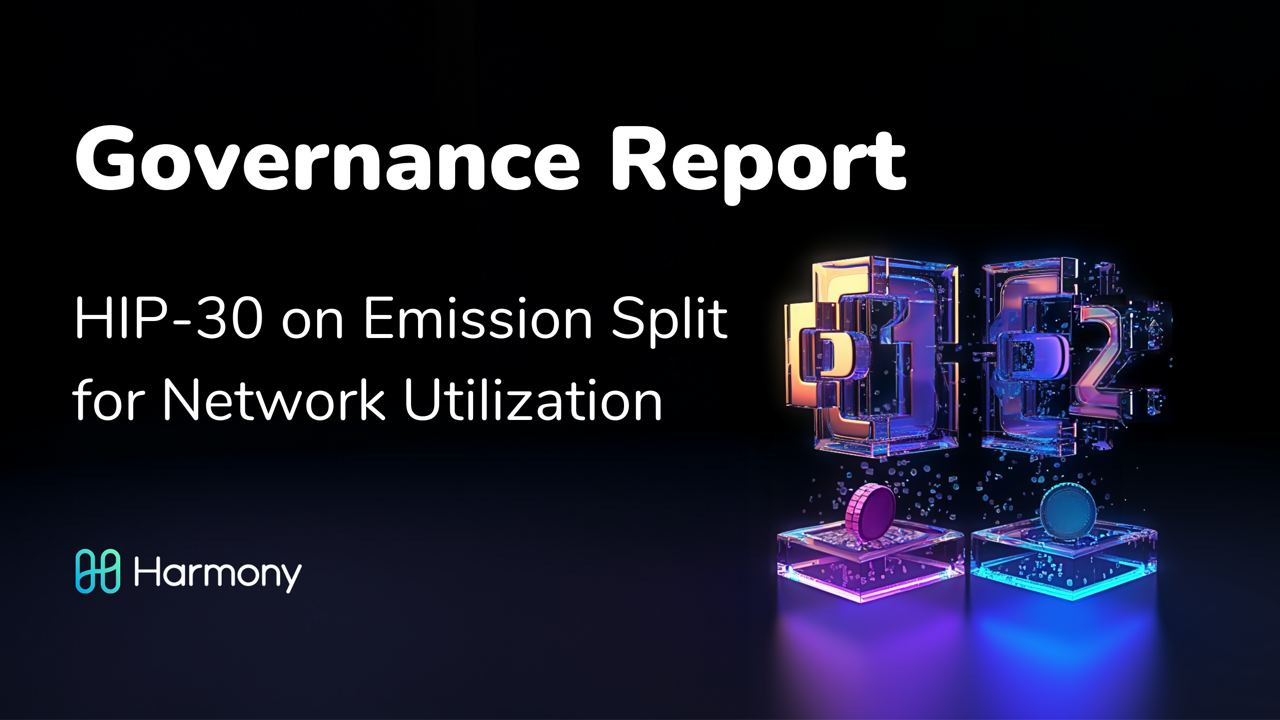Governance Report: HIP-30 on Emission Split for Network Utilization
Below covers Harmony Improvement Proposal HIP-30 and its common questions. The proposal aims to enhance our platform utilization, accelerate bridge recovery, and foster ecosystem growth. Its improvements are splitting token emissions and optimizing network structures.
Talk to your validator – and vote! The official snapshot is here.
Summary of HIP-30
Change the number of shards from 4 to 2, and nodes from 1000 to 450.
Split the annual token emissions: 45% to staking and 55% towards recovery and growth.
Optimize nodes per shard towards 1-second finality.
Raise minimum validator commission from 5 to 10%.
How will the annual 442M token emissions be split?
199 millions (45%) for staking validator and delegator rewards, 243 millions (55%) for bridge recovery and ecosystem growth.
Why not a gradual split from 25% instead?
Our top goal is to improve network utilization rate matching the levels of Ethereum and Cosmos networks. Currently, our network usage is lower than 0.1%.
The emission per key remains constant but our network demand has changed. Further decrease in network size and related emissions may be necessary as our usage is down 100x from peak.
The emission split is strongly allocated to the bridge recovery so users can then grow our network utility.
Why reducing the number of shards and nodes?
The total number of nodes for Shard 1 will be decreased from 250 to 200 (with 180 external). The reduction aims to enhance the network's utilization rate and accelerate its development towards achieving 1-second finality.
Why increasing the minimum validator commission?
The increase in the minimum validator commission from 5% to 10% aims to incentivize more robust validator participation, which is crucial for maintaining the network's security and utilization rate.
Will there be a cap change in validator BLS keys?
No, Boneh–Lynn–Shacham (BLS) keys for validators is unchanged, remaining at the 6% limit. Maximum keys for a validator will be reduced from 52 to 23 because of fewer shards. This results in a maximum of 13 keys on Shard 0 and 10 keys on Shard 1.
How will EPoS (Effective Proof-of-Stake) look like?
Based on total public key reduction from 900 to 405:
Current effective median stake * (900/405) = New effective median stake
Upper Bound = 16,251,369
New effective median stake = 12,038,051
Lower Bound = 7,824,733
72 validators in the current staking dashboard meet this lower bound.
This preliminary analysis does not include dynamic changes in total network stake or potential transitions amongst validators – which would change the effective median stake and the number of validators.
What is the Emission DAO?
Emission DAO, with the control of our network token emission besides staking, will be formed and governed by Harmony’s community, ecosystem, and partners. Its mandates, members, and operations will be defined in an additional governance proposal in the first year after HIP-30.
After the approval of HIP-30, discussion, proposal, and election will begin for Emission DAO. Before the DAO is formally approved and operational, the emission funds will be continually directed to bridge recovery. If the recovery is fully completed, the funds will keep accumulating in the same multi-signature wallet pending further proposals.
That is, no funds from emission will be used for anything other than recovery before the DAO is setup. A separate Snapshot will vote on the full structures of Emission DAO.
Can this be split into multiple proposals?
The proposal looks at network utilization as a whole. The number of nodes and emissions are changing proportionally from 1000 nodes to 450 nodes so the proposed network size will be 45% and the proposed emission to the network will be 45% of the current network.
This emission split accelerates our bridge recovery and brings more users for upcoming decentralized finance & AI applications on Harmony.
Discuss and Vote
The official snapshot is here. This HIP-30 proposal improves Harmony's network and token emissions, optimizing for platform utilization, bridge recovery, and ecosystem growth.


